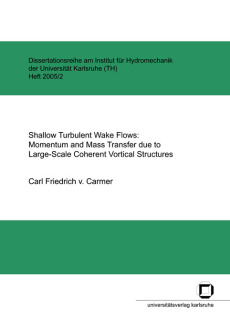Carl F von Carmer
Shallow turbulent wake flows: momentum and mass transfer due to large-scale coherent vortical structures
Reihe: Dissertationsreihe am Institut für Hydromechanik der Universität Karlsruhe (TH)Shallow turbulent wake flows are generated by large obstacles – like islands or headlands – introduced to shallow turbulent open-channel flows. Large-scale quasi two-dimensional vortices may shed off from an obstacle, and advect downstream in a vertical shear flow with predominantly small-scale turbulence induced by bottom friction. Experimental, analytical, and numerical techniques are employed in the present study to characterize the mean flow and turbulence properties of shallow wakes; mechanisms of generation and decay of large-scale vortical structures are clarified, as is their influence on momentum and mass transport in shallow wakes; the global and local stability of shallow wakes is analyzed and evidenced from experimental data. Part I of this work covers non-intrusive optical measurement techniques especially adapted to investigate shallow shear flows. Flow velocities and mass concentrations are obtained (i) point-wise with high spatiotemporal resolution using a combinded LDV-LIF system, and (ii) field-wise using near-surface PIV and depth-averaged PCA systems with a coupling by phase-resolved averaging. Improved algorithms for the evaluation of mass concentrations are based on hydro-optical models of the underlying fluorescence and light attenuation processes. Part II addresses the time-mean description of shallow wake flows. The stochastic description of the turbulence fields displays a characteristic spectral distribution both of kinetic energy and of mass variance, which is partially consistent with the theory of unbounded 2D turbulence at large scales, and with the theory of homogeneous 3D turbulence at small scales. An integral wake model including the effect of bottom friction is derived analytically, and is validated by experimental data. The time-mean distributions of flow velocities and of mass concentration allow to identify wake near fields and far fields with specific asymptotic wake developments. Wake stability classes are associated with local stability regions suggested by linear stability analyses. Part III elaborates the structure and dynamics of quasi-periodic wake flows and the significance of large-scale eddies. This involves a structure identification scheme to educe individual vortices, and a phase-resolved averaging procedure to decompose the flow fields into large-scale coherent and small-scale turbulent parts. A Numerical Particle Tracking technique is employed to model the mass transport and to elucidate different diffusion and dispersion effects.

